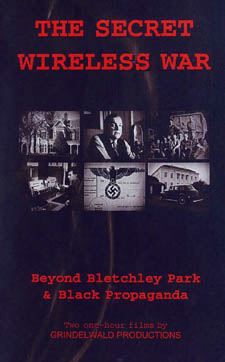| |
|
Reviewed by Jerry Berg, jberg@ontheshortwaves.com
I knew I was going to like this video from the early scene showing wartime Voluntary Interceptor (VI) Bob King tuning a modern transceiver in his reconstructed World War II radio shack, recalling the words of an unknown CW poet:
I
must go back to the set again, to the superhet and the phones,
And switch
off the broadcast music, the announcer's measured tones,
And search
again on the short waves, with loud calls blending,
For the
dim sounds of the Morse code, that a far foe's sending.
I
must go back to the set again, for the time has come to seek,
In the
QRM and the QRN, for my allotted squeak,
And all
I ask is a steady note, through the ether speeding,
At a fair
strength, in a quiet spot, at a nice speed for reading.
 "The Secret Wireless War"
comprises two separate one-hour programs, "Beyond Bletchley
Park," covering British interception of German wireless signals
during the war, and "Black Propaganda," covering the
development of the World War II British black clandestine broadcasts.
"The Secret Wireless War"
comprises two separate one-hour programs, "Beyond Bletchley
Park," covering British interception of German wireless signals
during the war, and "Black Propaganda," covering the
development of the World War II British black clandestine broadcasts.
"Beyond Bletchley Park" focuses on project "Ultra," Britains's effort to pick up weak German radio signals, decipher and analyze them, and make them available to Allied field commanders. Told through the reminiscences of several early participants, it covers both the Radio Security Service of MI5, and the much larger "Y" service of military wireless intercepts. The RSS included some 1,500 unpaid ham Voluntary Interceptors, secretly monitoring the airwaves, initially listening for transmitters in the U.K. thought to be operated by enemy agents, but eventually concentrating on German intelligence signals from the mainland of Europe. This effort led to the creation of a full-time monitoring operation in England.
Other topics addressed include the Lorenz Code which was broken by the huge Colossus computer; "Station X," the MI6 transmitter used to contact agents in neutral countries; Whaddon Hall (MI6 headquarters); early direction finding; and the Special Liaison Units which were used to communicate intelligence to the field and which included Packard autos stuffed with radio gear. The program shows many things of interest to shortwave fans, including pictures of Bletchley Park and environs (BP was the home of the Enigma code breaking team), the Bletchley Park Wireless Museum, pictures of old RSS log sheets, receivers--from two-tubers to National HROs, RCAs, Eddystones, etc.--and the Mark 7 spy radio sets.
"Black Propaganda" is likewise told through the eyes and words of those who lived it, in this case principally Phil Luck, Transmitter Engineer for the Special Communications Unit which operated the shortwave and medium wave transmitters that carried much of the British black propaganda to the European mainland. The story of Sefton Delmer and the Milton Bryan facilities has been told before. What makes this version different is its reliance on first-person accounts. The video includes photos of early recording studios, antenna farms and transmitter buildings, and explanations of how the programs were produced, delivered to the transmitters and broadcast on air. The viewer is taken on a visit to the old transmitter facilities, where Phil Luck describes what it was like to work there many years ago. Here as well is the story of the 600 kw. Aspidistra transmitter, and also the "paper" side of the Political Warfare Executive that included the production of leaflets, newspapers, false stamps, ration cards, etc. (including false horoscopes whose predictions of dire consequences were intended to discourage superstitious U-boat captains from setting sail).
Students of World War II radio history will recognize the names of the stations discussed: on shortwave, Gustav Siegfried Eins and Atlantiksender, and on medium wave, the highly successful Soldatensender Calais (later Soldatensender West). Brief recordings of some of their programs are heard as well. A particularly interesting part of the video is when narrator Debra Rixon looks through an old trunk belonging to the late Ted Halliday, the ex-BBC broadcaster who ran Milton Bryan. In the trunk are old organizational charts, notes, hand drawn caricatures of friends and associates, etc.
"The Secret Wireless War" is a production of Grindelwald Productions, P.O. Box 38, Princes Risborough, Bucks. HP27 9YL, England, grindelwald_prods@lycos.com. The video is available at a current price of US$33, which includes airmail shipment. Payment can be made via Paypal, or (for U.S. purchasers) by U.S. check on a U.S. bank. For more details see www.grindelwald.co.uk